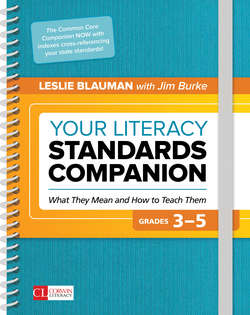Читать книгу Your Literacy Standards Companion, Grades 3-5 - Leslie Blauman - Страница 52
На сайте Литреса книга снята с продажи.
Common Core Reading Standard 4: What the Teacher Does
ОглавлениеTo determine the meaning of words and phrases as they are used in a text:
Generate a vocabulary chart at the outset of a new nonfiction unit or chapter. Don’t be afraid to explicitly teach key words up front, with the idea that students will take ownership of figuring out plenty of challenging words in the subsequent reading.
Think aloud while reading to the class to show how you puzzle out a word or phrase using syntactic, semantic, typographic, etymological, and other types of information to decipher words. Invite students to try a word.
Teach students to look all around the words phrase as though they’re hunting for something on their closet floor! Is there a word part they know? What about the other words in the sentence—is the challenging word part of a series of like things (e.g., Lions eat deer, zebras, mice, and ______________)? What clues are on the page (captions, diagrams, images)? Does the author define it a sentence or two later?
Point out the way authors use explanations, synonyms, restatement (e.g., in other words . . . ), contrast, or antonyms, which can help you know a challenging word.
Encourage students to mark unknown words in their texts with sticky notes as they are reading independently and then to go back and determine meaning. Check in with students in small group or in conferences on how they are using this strategy.
Use a shared text to have students highlight unknown words and annotate in the margins.
When working with the whole class or small groups or conferring one-on-one with students, encourage them to acknowledge when they don’t know a word or phrase.
To determine the meaning of words and phrases as they allude to significant characters found in mythology:
Brainstorm a list of words that harken back to mythology (e.g., Herculean, Trojan Horse, Phoenix, to Harp, fate, fury, leave no stone unturned, Achilles’ Heel, Midas Touch, Mentor, Nemesis, Phobia). Read or discuss the myths where these are referenced and discuss what they mean, especially in the context of character description or events in a text.
Keep a class list or illustrated chart of famous characters in mythology.
Invite students to find words or phrases in their own reading that allude to significant characters in mythology and share these with the class.
To determine the meaning of figurative language such as metaphors and similes:
Choose texts rich with figurative language and discuss the language as you read aloud to the class.
Teach explicitly the different types of figurative language (simile, metaphor, analogy, personification, etc.) and why they are used in text. Keep class charts of examples of figurative language from shared texts or have students record examples in their writing notebooks or journals.
Use shared texts of poetry under a document camera or projected on an interactive whiteboard to find examples of figurative language, name them, and annotate how they lead to meaning of the text or create visual and sensory images.
To distinguish between literal and nonliteral language:
Think aloud using a shared text (or screen or under a document camera) to highlight in one color literal language—and in another color nonliteral language, discussing how they are different and how they lead to overall understanding of the text.
Identify nonliteral language and discuss what it means within the text; then determine the literal meaning of those words; then model, or ask students, to determine, in light of how they are used, the figurative or nonliteral meaning.
Continue to explicitly draw attention to literal and nonliteral language in shared texts.
To determine the meaning of general academic and domain-specific words in a text:
Show students how to make use of any textual features—sidebars, captions, typography (is the word in bold and thus in the glossary), diagrams, footers, or glossaries in the chapter or in the appendix.
Teach students, when appropriate, the root words or etymology of certain subject-specific words (bio = life, ology = study of) as part of the study of any discipline.
To help your English language learners, try this:
Create pictures for words and visual representations for figurative language. Use these words as often as possible, speaking them aloud so students hear them used in context and pronounced correctly. Write words, model pronunciation, and provide opportunities for students to use it often in context.
For graphic organizer templates, see online resources at resources.corwin.com/literacycompanion3-5.
